Primate is a member of the group of mammals made up of human beings and the animals that most closely resemble them. Scientists classify hundreds of living species (kinds) of mammals as primates. These diverse animals range in size from 1 ounce (28 grams) to almost 400 pounds (181 kilograms). Most primates belong to one of two major groups, commonly known as prosimians and anthropoids. Prosimians include lemurs. They generally have a smaller body size than other primates. Anthropoids consist of monkeys, apes, and human beings. One small group of primates, the tarsiers, have characteristics of both prosimians and anthropoids. But scientists consider them more closely related to anthropoids. Biologists classify anthropoids and tarsiers in a group called the Haplorhini. They classify prosimians in a group called the Strepsirhini.
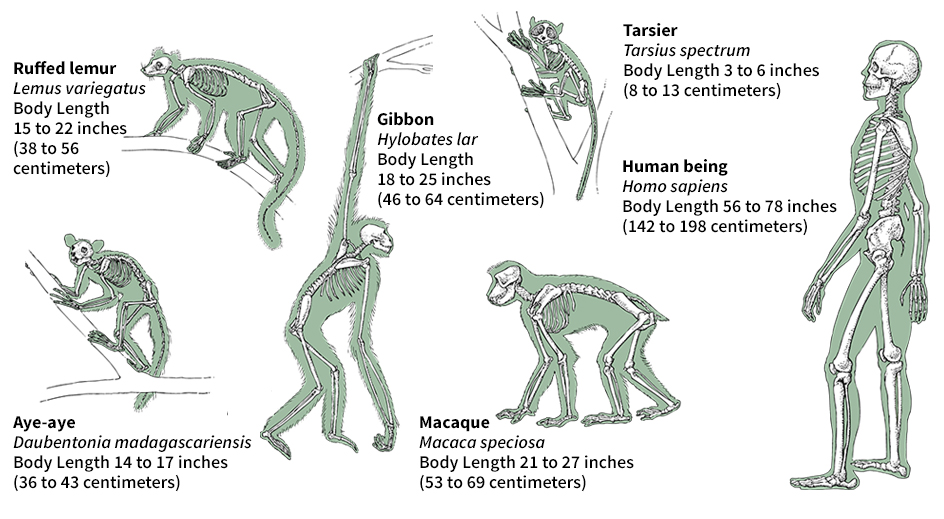
Primates share certain traits in common. The first primates evolved as tree-living animals. Thus, they developed grasping hands that enabled them to hang onto branches and move easily from branch to branch. Most primates also have grasping feet. Some even have grasping tails. Primate eyes face forward, providing excellent vision. Most species rely more on sight than they do on hearing or smell.
In general, primates have large brains. They rank among the most intelligent and social of animals. Many species live in large, complex social groups. Most primate young take a long time to mature, so they rely heavily on their mother. The young learn much from her. For example, they learn what to eat and what things to avoid.
Most scientists believe that the earliest primates evolved around 65 million years ago. Nonhuman primates once occupied more of North America, Europe, and Asia than they do today. At present, almost all nonhuman primates inhabit tropical climates in Africa, Asia, and South America. Many of them have become threatened with extinction.
Kinds of primates
Prosimians
are the more primitive of the two major groups of primates. Most prosimians, including lemurs, live on the island of Madagascar off the southeast coast of Africa. Other prosimians inhabit Asia and continental Africa. These animals include galagos, lorises, and pottos.
Lemurs
are the most diverse group of prosimians. The smallest lemur, the pygmy mouse lemur, weighs about 1 ounce (28 grams). The largest lemur, the indri, weighs about 20 pounds (9 kilograms). Lemurs have projecting front teeth that form a “tooth comb.” They use it to groom themselves and each other. They also use a claw on the second toe of each foot for grooming. Many lemurs have long lower limbs and short upper limbs. These limbs enable them to leap gracefully from branch to branch.
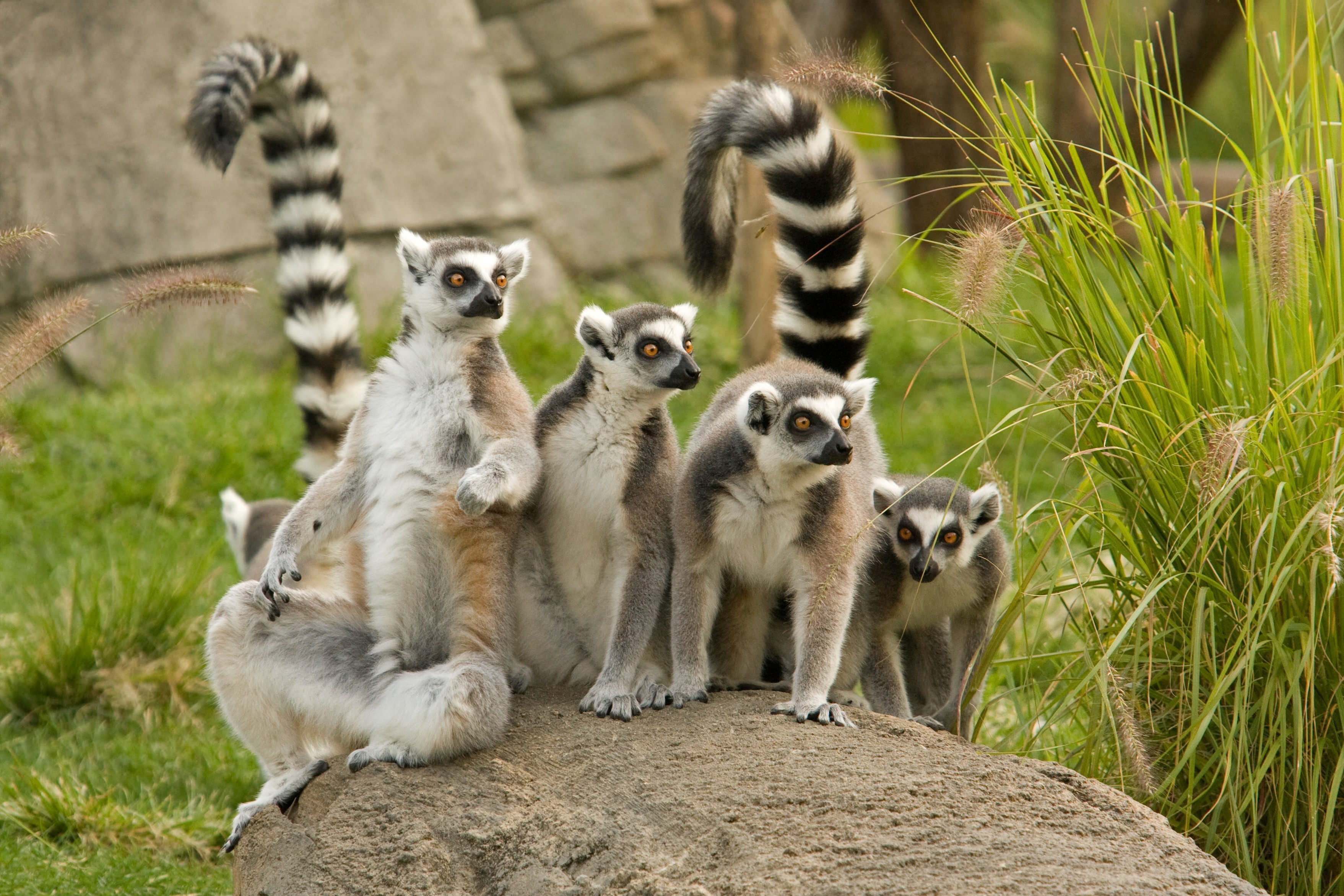
Lemurs live in social groups that often vary from 10 to 20 individuals. Some species are diurnal (active during the day). Others are nocturnal (active at night). See Lemur.
Aye-ayes rank among the rarest of all primates. These nocturnal lemurs grow to about 7 pounds (3 kilograms) in weight. Insects are their most important food. They search for insects using some remarkable body features. First, they gnaw through tree bark with their incisors. Their incisors grow continuously. Then they use a long claw on the third finger of each hand to probe for insects within the tree. Unlike other lemurs, aye-ayes live alone. See Aye-aye.
Galagos and lorises
are two closely related types of nocturnal prosimians. Both live in Africa. Lorises also inhabit India and Southeast Asia. Like the lemurs, galagos and lorises have “tooth combs” and a grooming claw on the second toe. Galagos have remarkable leaping ability. Although these primates measure only 4 to 18 inches (10 to 46 centimeters) long, some can jump more than 61/2 feet (2 meters). Lorises, however, move slowly in trees. See Galago; Loris.
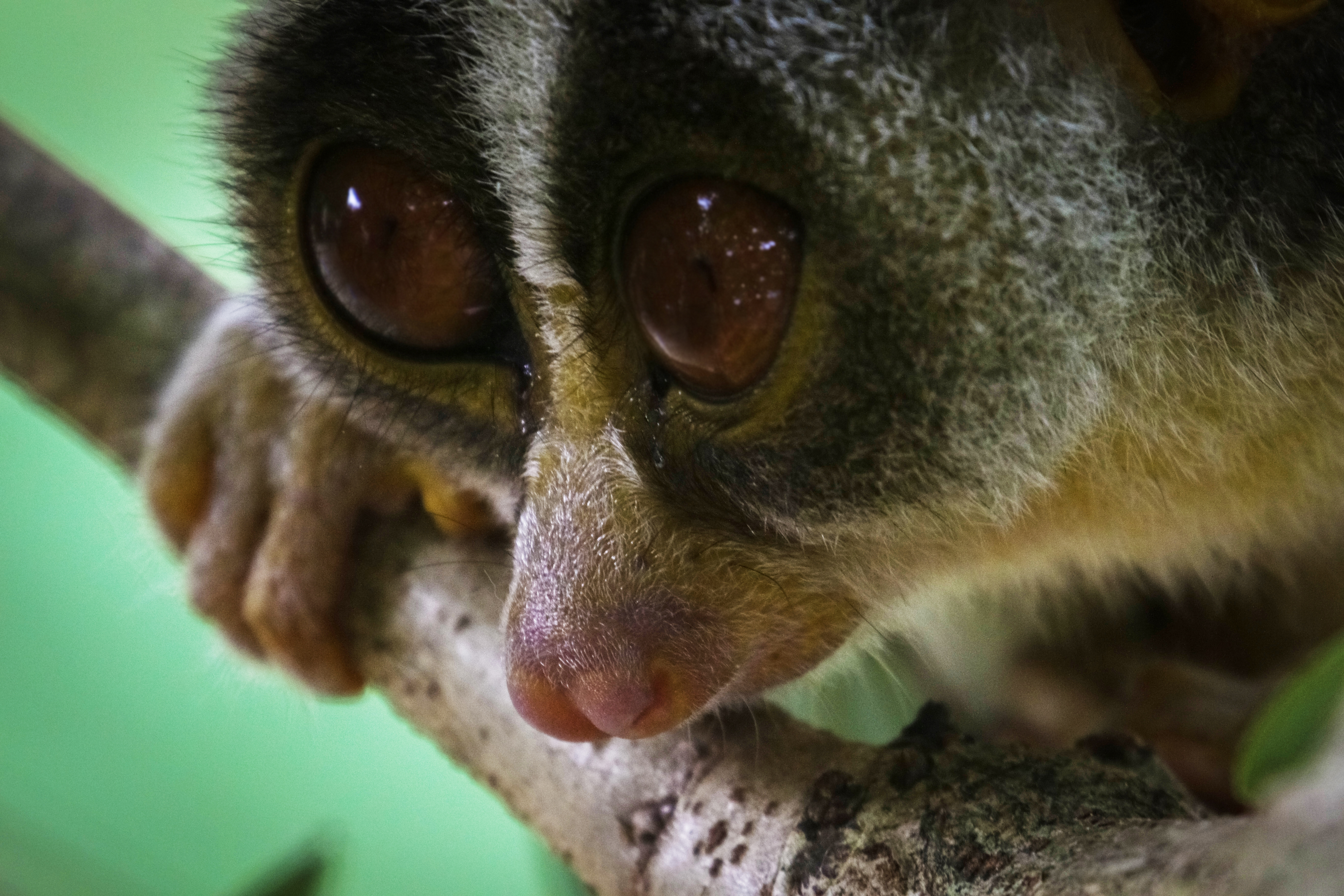
Tarsiers
are small, nocturnal primates of Southeast Asia. They resemble prosimians in some respects and anthropoids in others. Scientists once thought tarsiers were closer to prosimians in their evolutionary history and anatomy. But now many biologists classify them closer to the anthropoids. The tarsiers’ nocturnal lifestyle resembles that of many prosimians. Tarsiers have huge eyes for excellent night vision. Each of these eyes is bigger than their brain. Tarsier skulls, however, resemble those of anthropoids more than those of prosimians. Tarsiers also have big hands and feet. Their hands help them catch prey. Their feet enable them to execute dramatic leaps in the forest. See Tarsier.
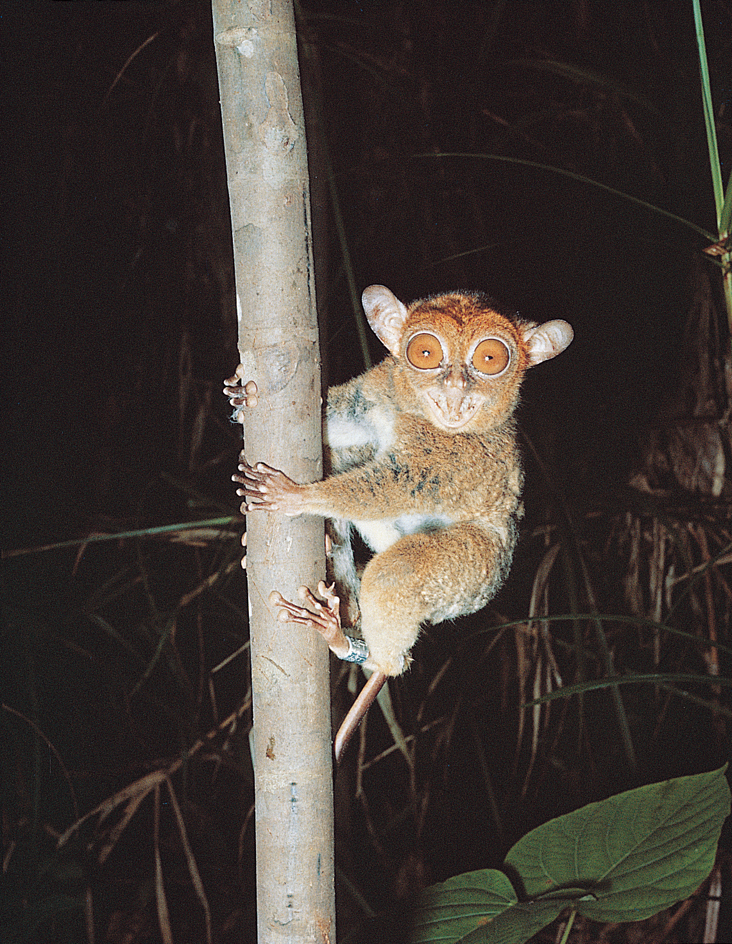
Anthropoids
constitute a much larger and more diverse group than do prosimians. New World monkeys range from Mexico through South America. Three other subgroups—Old World monkeys, the lesser apes, and the great apes—inhabit Africa, Europe, and Asia. Human beings live throughout the world.
The bodies of anthropoids differ from those of prosimians. In monkeys, apes, and human beings, the two sides of the lower jawbone are fused together. These sides remain unfused in prosimians. Anthropoid and prosimian skeletons also differ. Most monkeys and apes have longer, better developed upper limbs than do prosimians. Their long upper limbs enable them to walk on all four limbs and swing from the branches of trees. Unique among anthropoids, human beings have long lower limbs and short upper limbs. This arrangement is better for walking full-time on two legs. Prosimians have a well-developed sense of smell. Anthropoids rely more on sight. Most of them have color vision. With the exception of the night monkeys of South America, anthropoids sleep at night and remain active during the day.
New World monkeys
inhabit forests from southern Mexico to northern Argentina. They have evolved separately from other monkeys for about 20 million years.
New World monkeys have certain body features that distinguish them from Old World monkeys. For example, the nostrils of New World monkeys generally lie farther apart than those of their Old World cousins. Some New World monkeys, such as the howlers, have a prehensile tail. The tail can “grasp” branches as a hand does, enabling the animals to hang by their tail. Prehensile tails have well-developed muscles. They also have sensitive fingerprint skin at the tip. New World monkeys generally have smaller, less useful thumbs than do Old World monkeys. Some species, including certain spider monkeys, have lost their thumbs completely.
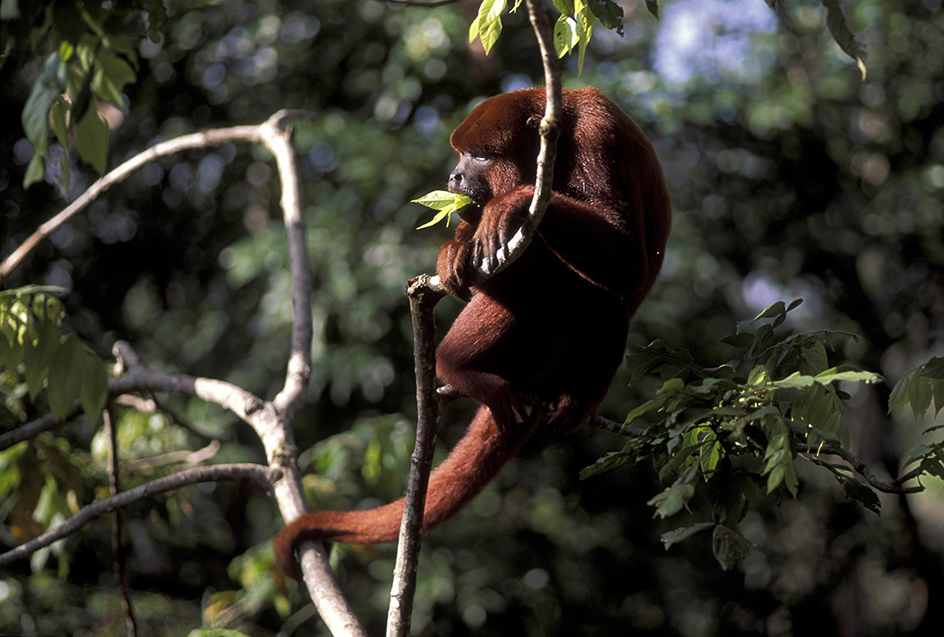
Two unusual types of New World monkeys, the marmosets and tamarins of South America, rank among the smallest primates. Marmosets weigh from 10 to 12 ounces (280 to 340 grams), and tamarins weigh from 12 to 27 ounces (340 to 770 grams). See Marmoset ; Tamarin .
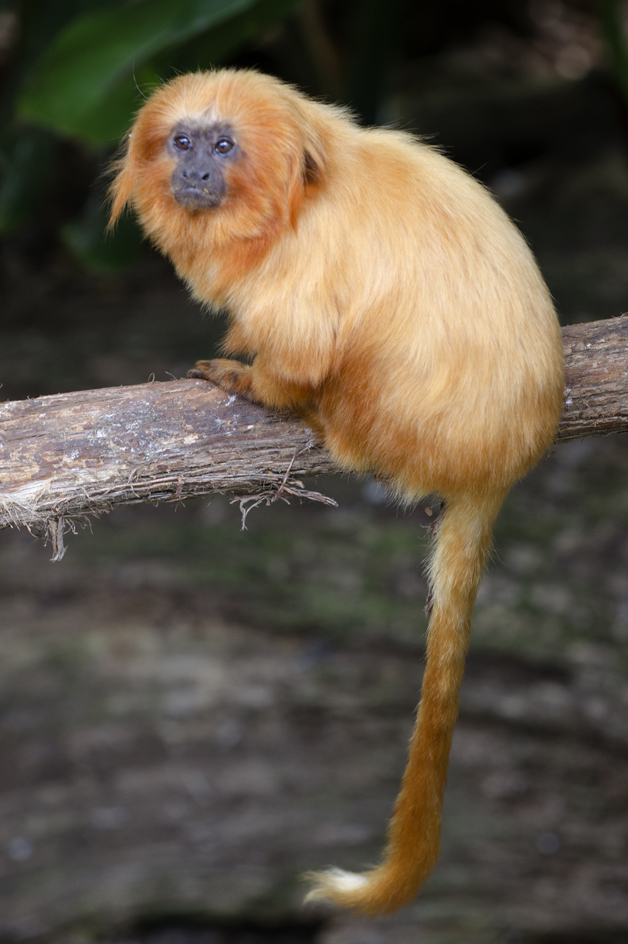
All New World monkeys live in trees. But different species occupy different layers of the forest canopy. New World monkeys live in a variety of social groupings. A number of them, including the woolly monkey, gather in groups of up to 70 individuals. Marmosets and others live in small communities of 15 or fewer.
Old World monkeys
live in Africa, Asia, and Europe. Most of these primates have a callous pad of skin on their rumps. The pad enables them to sit and sleep more comfortably in trees. They also tend to grow larger on average than New World monkeys. Numerous species spend at least part of their time on the ground.
Old World monkeys consist of two groups: the colobines and the cercopithecines. Colobines include the langurs of Asia and the colobus monkeys of Africa. Colobines eat primarily leaves. They digest the leaves with their large multichambered stomachs. But like all primates, leaf eaters also consume other types of food. Colobines have longer legs, shorter thumbs, and longer tails than do cercopithecines.
Cercopithecines include the macaques, which live in Asia, Africa, and Europe; and the baboons, mangabeys, and guenons of Africa. Cercopithecines have simpler stomachs. They also have cheek pouches. They can stuff the pouches with food for temporary storage. See Macaque .
Old World monkeys inhabit a diverse range of climates. Their habitats include deserts, tropical rain forests, and colder mountainous regions. The Japanese macaque of Japan lives farther north than any other nonhuman primate. A number of Old World monkeys form complex social groups. Baboons, for example, gather in groups of up to 90 individuals. This larger gathering consists of several smaller groups of about five females and a dominant adult male. Baboons spend more of their lives on the ground than any other monkey. See Baboon .
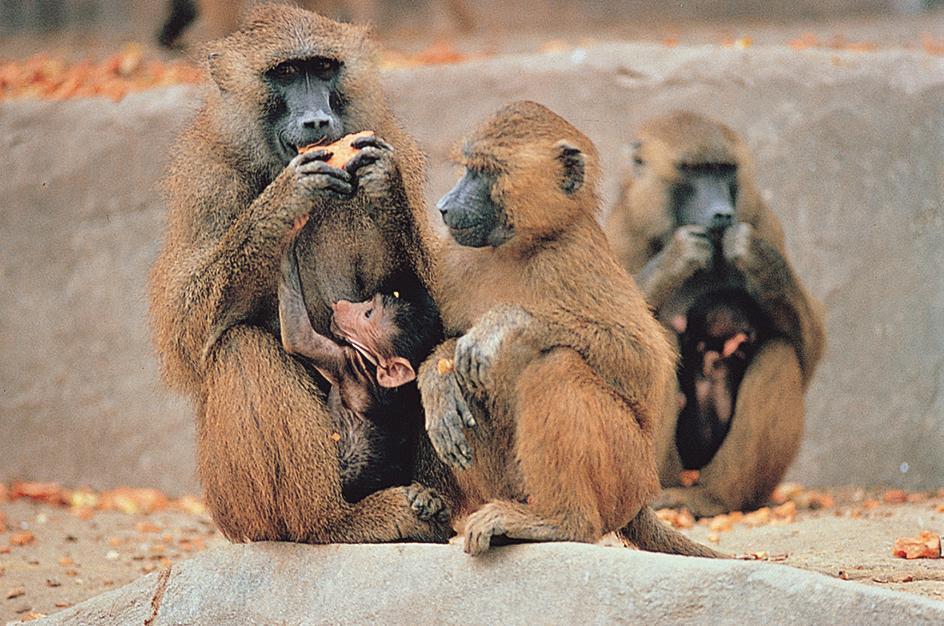
Lesser apes
include the gibbons and the siamang of Southeast Asia. These primates, along with great apes and human beings, have no tail. Gibbons and siamangs also have long upper limbs. Their long arms enable them to hang acrobatically under branches and swing from branch to branch. They also walk bipedally (on two legs) high in the trees. Biologists call gibbons and siamangs “lesser apes” because they grow about the same size as many monkeys. Lesser apes also have sitting pads on their rumps, as have Old World monkeys. In the wild, gibbons and siamangs mate for life. They eat mostly fruits and leaves. See Gibbon .

Great apes
include the orangutan of Southeast Asia and the bonobo, chimpanzee, and gorilla of Africa. Great apes have no tail. Unlike lesser apes, they lack sitting pads on their rumps. Thus, they need to build nests in the trees or on the ground for sleeping. Great apes are more closely related to human beings than any other type of primate.
The orangutan ranks as the largest arboreal (tree-dwelling) animal. Males weigh on average 180 pounds (80 kilograms). Females average 81 pounds (37 kilograms). Orangutans inhabit rain forests on the Southeast Asian islands of Borneo and Sumatra. Because of their arboreal existence, orangutans have developed huge hands and feet with long, curved fingers and toes. They have long, powerful upper limbs. They also have flexible joints, especially in the shoulders, hips, wrists, and ankles. Orangutans live more solitary lives than do most other primates. Males forage alone for fruit, their main food. The only social bonds occur between females and their offspring. Adult males and females interact only to mate. See Orangutan .

Gorillas grow larger than any other primate. Some wild male gorillas weigh as much as 390 pounds (177 kilograms). Females weigh about half as much as males. The three gorilla subspecies—the mountain gorilla, the eastern lowland gorilla, and the western lowland gorilla—all live in central Africa. Gorillas spend most of their time on the ground. They eat largely plant foods. They usually live in small groups. Most social interaction occurs between females and their young or between adult males and adult females. See Gorilla .
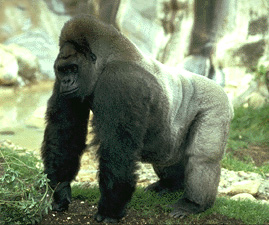
Chimpanzees are the most widely distributed of all the great apes. They range from dry woodlands in western and eastern Africa to humid rain forests in the Congo Basin of central Africa. Chimpanzees spend part of their day in the trees and part on the ground. They eat primarily fruit. They also consume leaves and insects. They even hunt for monkeys and other mammals. Males usually do the hunting in small groups. They try to keep the meat for themselves. Other chimpanzees gather around the hunters and get some of the meat by begging or stealing. In chimpanzee societies, males and females form separate groups at times and live together at other times. Chimpanzee behavior also includes activities that scientists once thought only human beings performed. These behaviors , include using tools and engaging in warfare with others of their own kind. See Chimpanzee .
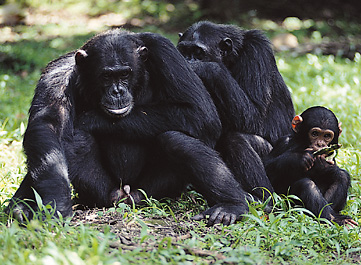
Bonobos, also called pygmy chimpanzees, live south of the Congo River in the Democratic Republic of the Congo. Bonobos resemble chimpanzees. But bonobos differ from them in many ways. Bonobo social groups consist of small bands of males, females, and young. The groups are part of larger communities that can include more than 100 individuals. Bonobos exhibit much less aggression within their groups than do chimpanzees. Bonobos also spend more time in the trees than their close relatives. Bonobos and chimpanzees share more characteristics with human beings than any other animal does. See Bonobo .
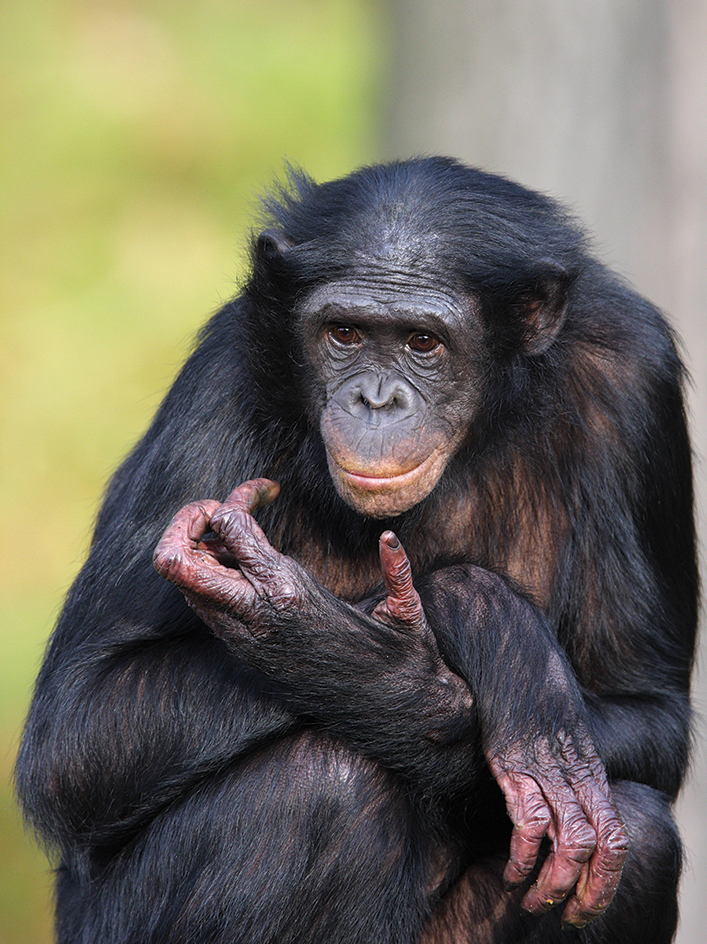
Human beings
rank as the most widespread of all primates. They are the only primates that permanently walk bipedally, or on two legs. They also have the most highly developed brain. They live in the most complex societies. These societies have developed sophisticated cultures (ways of behaving and thinking). However, the rapid growth of human populations represents a major threat to the survival of all other primates. See Human being .
The evolution of primates
Primates have a long evolutionary history that spans roughly the last 65 million years. The first known primate, called Purgatorius, probably developed in North America. It lived during the end of the Cretaceous Period and the beginning of the Paleocene Epoch. Scientists know little about Purgatorius because only a few fossil jaws and teeth have been found. From the middle to late Paleocene, slightly more evolved primates called plesiadapiforms appeared. This diverse group of small mammals resembled rodents or shrews. They inhabited North America and Europe.
Modern primates evolved in the first part of the Eocene Epoch, about 56 million years ago. Two groups, the adapids and the omomyids, emerged at this time. They became more abundant than earlier primates. Some scientists believe that adapids evolved into the first monkeys and apes. Others consider the omomyids to be the true ancestors of monkeys and apes.
According to fossil evidence, both the adapids and omomyids more closely resembled living primates than did plesiadapiforms. They had larger brains. They also had shorter faces and a bony ring encircling each eye. Adapids and omomyids relied more on sight and less on smell than did earlier primates. They developed hands and feet that could more easily grasp tree branches and other objects.
During the end of the Eocene Epoch and the beginning of the Oligocene Epoch—from about 40 million years ago to about 34 million years ago—the first true monkeys and apes appeared in the Eastern Hemisphere. Scientists have discovered a few fossil primates in Southeast Asia from the Eocene Epoch. These primates include Amphipithecus, Eosimias, and Pondaungia. They may represent the oldest anthropoids. But many scientists still believe animals called parapithecids were the first true anthropoids. Parapithecids lived During the Oligocene Epoch in what is now Egypt. Another group of Oligocene primates from Egypt, the propliopithecids, probably represent the first true apes.
The earliest known members of the hominin family, to which human beings belong, may have lived about 7 million years ago, during the Miocene Epoch. Modern human beings evolved during the Pleistocene Epoch. The Pleistocene lasted from about 2.6 million to 11,500 years ago.
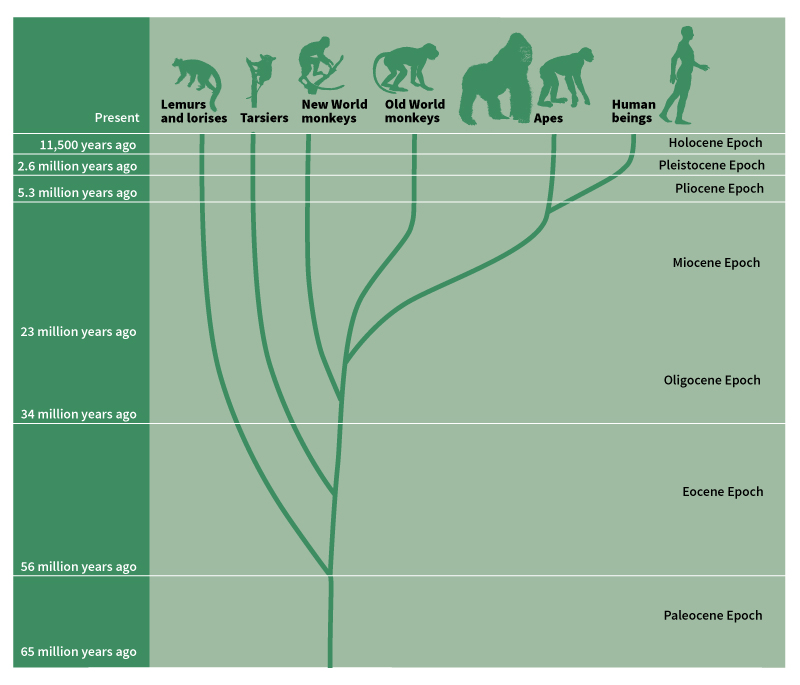
People and nonhuman primates
The study of modern primates.
Primatologists are the scientists who study nonhuman primates. These scientists have learned much about our closest relatives. Studies of great apes have revealed much about the evolution of our own species. Such studies have also disproved much of what we once believed about these animals. The work of the British primatologist Jane Goodall, for example, showed that chimpanzees use tools and engage in tribal warfare against other chimpanzees. Scientists once believed only people displayed such behaviors.
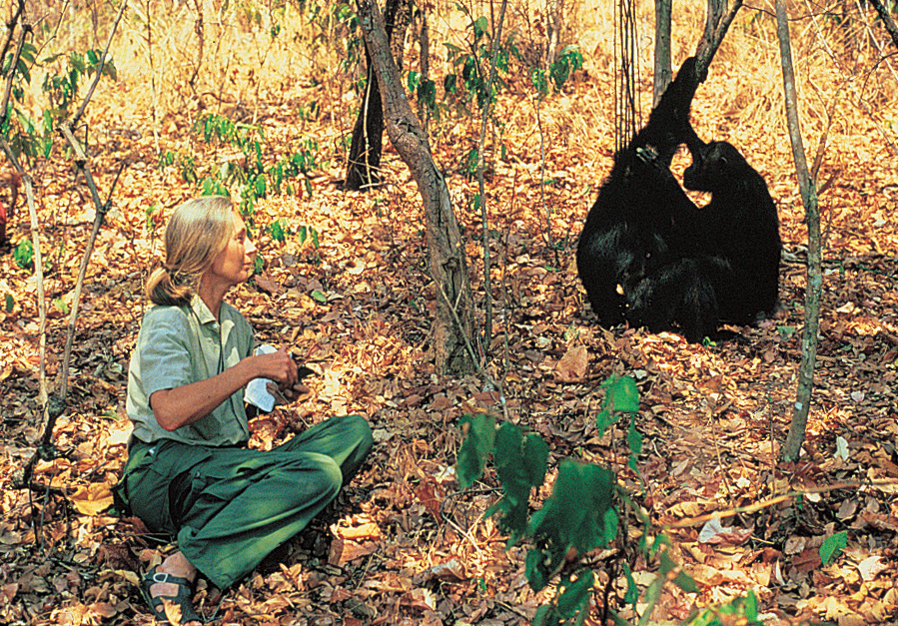
Some important primate research takes place in laboratories. For example, laboratory studies of the genetic makeup of chimpanzees have revealed how closely these primates are related to human beings. Other scientists are working to produce clones, or genetic copies, of monkeys. Such clones may prove useful in medical research.
Conservation.
Today, nonhuman primates survive mostly in remote tropical areas that have little contact with humans. Some of the areas inhabited by primates remain unknown to science. Since 1990, in fact, scientists have discovered and described dozens of new primates in Madagascar, continental Africa, Southeast Asia, and Brazil.
But even while primatologists identify new species in the wild, the survival of many more primate species has become threatened. The chief threat to their survival is habitat destruction. Economic pressures in developing countries often drive people to cut down the rain forests for wood and for agriculture. Other human activities also endanger primates. Some of the ways human beings threaten primate survival are disturbing. Such activities include the illegal trade in pets, the use of primate tissues in traditional medicine, and even the hunting of primates for food.
Some of the most endangered primates include our closest relatives, the great apes. The International Union for the Conservation of Nature and Natural Resources (IUCN) lists all the great apes as threatened or endangered. The mountain gorilla ranks as the most highly endangered. Only a few hundred individuals survive in the Virunga Mountains of East Africa. In addition to habitat destruction and hunting, persistent political and economic instability in Africa and Asia further threaten the survival of our closest relatives. To continue learning about ourselves and our relationships to the natural world, human beings must take responsibility for preserving primates and their habitats.
